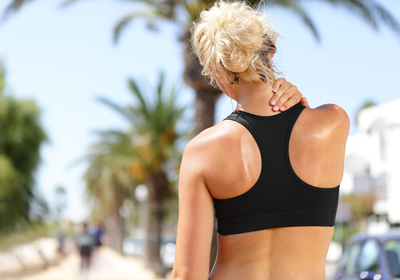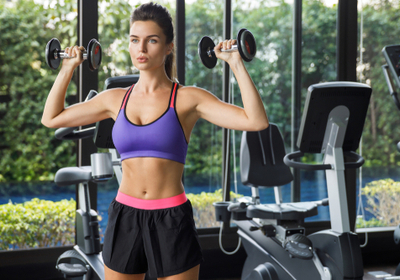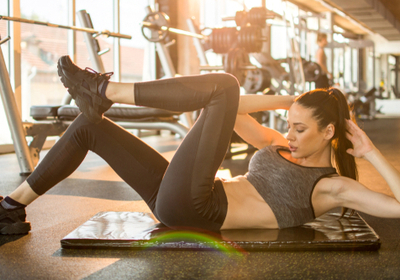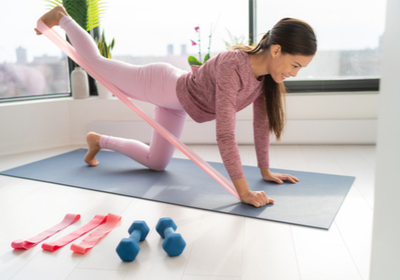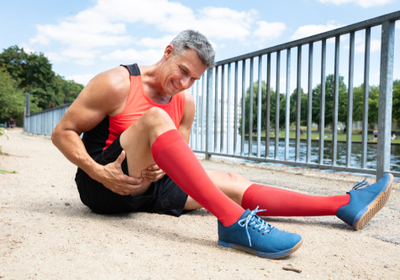VIDEO
Dumbbell Overhead Lunge
- Core
- Biceps
- Upper Back
- Shoulders
- Gluteus
- Quads
- Hamstrings
Level:Intermediate
Trainer:Nick Anderson
Equipment:Dumbbell
Dumbbell Overhead Lunge
- Core
- Biceps
- Upper Back
- Shoulders
- Gluteus
- Quads
- Hamstrings
Level:Intermediate
Trainer:Nick Anderson
Equipment:Dumbbell
Stand straight with your feet shoulder-width apart, holding the dumbbell in right hand over your head. Make a lunge forward with your right leg breathing in. Breath out and get back to the starting position. Then repeat the lunge with the left leg.
save to ...
RECOMMENDED FOR YOU
Pike and Tuck Burpees
- Core
- Back
- Biceps
Duaration: 00:15
save to playlist
Side to Side Jumps, Forward High Kicks, Squat Jacks
- Core
- Legs
- Gluteus
Duaration: 00:15
save to playlist
Reverse Lunge
- Gluteus
- Quads
- Hamstrings
Duaration: 00:40
save to playlist
Mountain Climbers
- Core
- Legs
- Abs
Duaration: 00:44
save to playlist
Frog Lunge
- Gluteus
- Quads
- Hamstrings
Duaration: 00:15
save to playlist
Twisting Lunge
- Lower Back
- Obliques
- Gluteus
Duaration: 00:16
save to playlist
Plank Jacks
- Core
- Biceps
- Lower Back
Duaration: 00:39
save to playlist
Barbell Romanian Deadlift
- Abs
- Triceps
- Lower Back
Duaration: 01:02
save to playlist
Wall Walk Variation
- Core
- Biceps
- Triceps
Duaration: 00:15
save to playlist
Pushup to Opposite Arm Opposite Leg Raise
- Core
- Biceps
- Upper Back
Duaration: 00:49
save to playlist
Single Leg Pushups, Handwalk Pushup, Knee to Elbow Pushup
- Core
- Biceps
- Trapezius
Duaration: 00:15
save to playlist
Burpee Variation
- Core
- Arms
- Back
Duaration: 00:15
save to playlist
Kettlebell Single Arm Thruster
- Back
- Biceps
- Shoulders
Duaration: 00:38
save to playlist
Depth Jump to Box Jump
- Gluteus
- Quads
- Hamstrings
Duaration: 00:45
save to playlist
Handstand Pushup
- Core
- Back
- Legs
Duaration: 00:15
save to playlist
Sprints
- Core
- Back
- Quads
Duaration: 00:43
save to playlist
Side Plank
- Core
- Back
- Shoulders
Duaration: 00:30
save to playlist
Knee Pump
- Abs
- Gluteus
- Quads
Duaration: 00:16
save to playlist
Stair Running, Scissors
- Core
- Biceps
- Triceps
Duaration: 00:15
save to playlist
Squat Jumps, Plank Jacks, ToeTouch Jump Squats, Plank Jumps
- Arms
- Legs
- Abs
Duaration: 00:15
save to playlist
Plank with Opposite Arm and Leg Lift, Pushups, Elbow Plank Variation, Plank Forward High Knee Lifts
- Core
- Arms
- Legs
Duaration: 00:15
save to playlist
Back Extensions
- Core
- Abs
- Lower Back
Duaration: 00:30
save to playlist
Lunges, Side Squat, Plank to Squat Jump, Side Plank Variation, Pushups, Side Plank Hip Dips, Double Leg Lifts, Bicycle
- Core
- Arms
- Legs
Duaration: 00:15
save to playlist
Dead Bug
- Core
- Shoulders
- Gluteus
Duaration: 00:30
save to playlist
High Knees Variation, Elbow Plank Variation, Plank Jumps Variation, Pushups, Long Arm Crunches
- Core
- Arms
- Legs
Duaration: 00:15
save to playlist
Bicycle Crunches
- Abs
- Obliques
- Hamstrings
Duaration: 00:35
save to playlist
Dumbbell Clean
- Biceps
- Upper Back
- Lower Back
Duaration: 00:54
save to playlist
V-Jumps
- Core
- Legs
- Abs
Duaration: 00:15
save to playlist
Plate Side Lunge, Squat Knee To Elbow, Frog Squats, Plate Over Head Squats
- Core
- Biceps
- Triceps
Duaration: 00:15
save to playlist
Kettlebell Side Lunge
- Biceps
- Lower Back
- Gluteus
Duaration: 00:48
save to playlist
Plank Knee to Elbow, Plank Jacks, Plank Leg Lifts
- Core
- Arms
- Legs
Duaration: 00:14
save to playlist
Jumps with Dumbbells
- Core
- Arms
- Legs
Duaration: 00:15
save to playlist
Scissors
- Core
- Quads
- Hamstrings
Duaration: 00:30
save to playlist
Superman Variation
- Core
- Arms
- Back
Duaration: 00:15
save to playlist
Squat Jump, High Knees, Plank Jumps, Jumping Jacks, Pushups, High Knee Jumps
- Core
- Legs
- Biceps
Duaration: 00:15
save to playlist
Single Leg Wall Sit
- Gluteus
- Quads
Duaration: 00:26
save to playlist
Rock Climbing, Run Up Slide, Pushups, One Hand Pushup, Rope Ladder Climb, Monkey Bars
- Core
- Arms
- Back
Duaration: 00:15
save to playlist
Single Leg Hip Raise
- Lower Back
- Gluteus
- Quads
Duaration: 00:30
save to playlist
Jumping Jacks Squat
- Gluteus
- Quads
- Hamstrings
Duaration: 00:15
save to playlist
Squat Walking
- Legs
- Gluteus
- Hips
Duaration: 00:15
save to playlist
Blog
Many athletes as well as sports enthusiasts focus on the workouts for the middle and lower back and ignore upper back exercises, which can lead to a number of negative consequences such as a slower rate of progression or even curvature of posture and muscle imbalance. Correctly selected load and good upper back exercises will help you effectively work out the desired area and, as a result, have a gorgeous body. So let’s talk about building upper back muscles.
Anatomy and Function of the Muscles of the Upper Back
Anatomically, the muscles of the upper back are represented by the two large areas, which are the trapezius and latissimus muscles. In addition to that, the back bundles of deltas are often referred to as the upper back, as they are involved in most exercises. But from the anatomical point of view, it is incorrect.
The trapezius muscles are responsible for the movement of the shoulder blades. They are attached to the back of the head at the top and to the spine at the bottom. These muscles are extremely important for posture and keeping the back straight. The latissimus muscles occupy almost the entire back area and are located on both sides of the spine. Latissimus muscles resemble wings in shape. It is important to understand that the upper back refers only to the part of the lats, which is located under the trapezium. The main function of these muscles is to bring the shoulder to the body and pull the arm back.
Peculiarities of Training
Even if your upper back is slightly undeveloped, you should not try to build this area by increasing the volume of loads. Such training will rather lead to hypertonicity of the trapezium and problems with the cervical spine than to beneficial muscle strengthening. Try to use no more than 2-3 upper body exercises per workout or put the same load on each part of the back, this will help “tighten” the lagging top without muscle imbalance. It is also recommended to alternate power and repetition modes (in micro-cycles or cycles). This will help to create the most versatile load, as well as balance the ratio of fast and slow muscle fibers, which is genetically set for each person. Finally, while training in the gym, make sure your exercises are diverse as well as focus on different parts of the upper back. If you prefer to exercise at home, do various exercises with dumbbells. You might also want to try rubber band workouts.
Workouts for Upper Back
Last, but not least, let’s have a quick look at some useful exercises for the upper back:
Reverse Fly
Barbell High Rows
T-Pulls
Upright Row
Y-Pulls
Seated Row
Renegade Row
Final Thoughts
Upper back muscles are very important for the right posture and general back health, which is why you should include some exercises for this muscle group in your workout routine. Find out lots of beneficial upper back exercises in our video tutorials.
Read more
A lot of people want to know how to build shoulders at home without dumbbells and other sports equipment at hand. Everything is very simple. Building the muscles of the shoulders, and especially the deltas are easily done with pull-ups and push-ups, which will help to get the shape of your dream.
Workouts for Building Shoulders
Push-upsFor the most part, this exercise will work with the pectoral muscles, but the shoulders will also be involved. A narrow position of the hands will involve the triceps and the middle delta in the work, and if you put your arms wider, then in addition to the middle part, you can also use the front delt muscles. In order to maximize the use of the muscles of the shoulders in the exercise, try to do push-ups a little higher, so that only the deltas work.
One-hand push-upsThis exercise is good for toning the shoulder girdle. It is important to take into account one point: the wider the legs are, the easier it is to perform the exercise, but the less the pressure on the muscles. So choose the best position for yourself.
Dumbbell ShrugsThis exercise is perfect for the shoulders muscles as well as the trapezius muscle. And your posture after doing this exercise regularly will be improved! Stand up keeping your body straight. Hands with dumbbells are lowered. Lift dumbbells, not with your hands, try to include only the shoulders muscles during it, lifting your shoulders as high as possible.
Sideways dumbbellsAlthough the exercise is basic, it is more suitable for athletes with a more advanced level. Doing dumbbells or swinging them is supposed to improve the work of the shoulders. So first of all, you need to stand up slightly leaning forward. In the initial position, the dumbbells are at the bottom. Let’s take a breath and spread them apart, trying to raise them as much as possible. When you get them at shoulder level, pause and gently lower your arms.
Barbell pressIt’s the most effective exercise for building up your shoulders. It is also called a standing barbell press. It is easy to do, firstly you need to put your feet shoulder-width apart, take the barbell with a straight grip and raise it to the chest. After that, you need to exhale and raise the barbell up. After that, you need to stay in this position for a second and slowly lower the barbell to the starting position, while inhaling deeply.
Wrapping Up
In order to quickly build perfect shoulders, you need a nice set of exercises, with which you will achieve maximum results. You can't just exhaust them with working hours in a gym. Follow the advice we gave you and you will get great results as soon as possible.
Read more
The path to beautiful abs should not start with the question 'How to strengthen abdominal muscles?' The thing is that the visual image of a flat stomach depends on the percentage of body fat. This means that the way your abs will look not only depends on the number of crunches you do but on the quantity and quality of your food. So today we are going to talk about the tips for getting gorgeous abs.
Abs vs Food
Nutrition is extremely important for getting abs. In fact, your coach will probably give individual nutrition recommendations after testing, but there is one universal rule that everyone should follow - eat healthy food. In particular, you should avoid eating bakery, sugar-containing foods, and salty snacks. On the contrary, you have to eat more vegetables, fruits, herbs, nuts and seeds, as well as meat or other high-protein foods.
Getting Started
Before starting a workout, it is important to obtain data on your body condition. This means that the best place to start is fitness testing. Your trainer will ask you some questions in order to learn about your lifestyle, test your ability to move, and measure you. Then the coach will recommend the activities that will be safe and effective for you.
Popular Abs Workouts
It is believed that the best ab exercises are the training of the rectus abdominis muscles, which perform the function of flexing the body and keeping it upright. But this is just the tip of the iceberg. You also want to work on the deep muscles, which are part of your core and include the muscles of the abdomen, back, thighs, and buttocks. Their function is to help the body maintain posture and balance in an upright position. As a matter of fact, if your core is not strong enough, you will most likely experience discomfort while doing other exercises. Strengthening the core should be your top priority and you can do that with the help of TRX loops, plank and its variations, as well other bodyweight exercises.
Exercises for Strengthening Core and Abs
As we have mentioned above, to have gorgeous abs, you have to make sure you not only work on your abdominal muscles but on your entire core. So here are some exercises for improving all these muscles:
Diagonal twists
Plank
Pushups
Plank push-ups
Crunches
Leg lifts from lying position
Wrapping Up
As you can see, getting gorgeous abs is totally possible if you know how to work on them. Healthy nutrition and regular exercises will help you sculpt the body of your dreams, so do not hesitate and start going toward your dream now.
Read more
The Kardashians set many beauty trends and one of those trends is gorgeous buttocks. So in this article, we will discuss how to build gluteus muscles and consequently look as hot as Kim, Kourtney, Khloé. Let’s start with the anatomy. The gluteus consists of three main parts:
Gluteus maximus muscle, which is the largest muscle of the body. It helps to maintain balance while walking and running, allows the leg to move outward, and it is also responsible for the tightened (or not so) shape of the buttocks.
The gluteus medius is partially overlapped by the gluteus maximus. It is located in the upper pelvis. It participates in the abduction of the leg to the side, lateral bending, and stabilization of the body during movement.
Finally, the gluteus minimus is located under the medius muscle. Together they are responsible for abducting the leg and stabilizing the body, as well as for forming the hip line.
Workouts for Gluteus
It's not that easy to build gluteus muscles, especially if you are limited in time. But if you work out at least three times a week and never give up, you will quickly reach your goal. In order to help you achieve your goal, we prepared the best exercises for developing muscles of the gluteal region. So here they come:
Barbell/dumbbell LungesThis exercise is ideal for those who are interested in pumping up the top of the buttocks and at the same time the back of the thigh. Begin the movement by bringing each leg one at a time forward. The thigh should be parallel to the floor and the knee should be at the right angle.
Barbell SquatThis is one of the basic exercises that help effectively build this muscle. From the starting position - legs apart, lower the pelvis just below the knees. Do not bend your lower back and make sure your knees do not surpass your feet. The wider your legs are apart, the greater the load on the buttocks.
Romanian deadliftsStand upright with your back slightly arched at the lower back. Holding the dumbbells in your hands, bend over, pulling your pelvis back. Once you reach the spot just below your knees, return to the starting position.
Dumbbell Split SquatsThe exercise is performed with a straight back, with one leg taking a step forward and throwing the other one on a stand from behind. Squat and do the exercise for both legs.
Back LungesStart in a standing position, take a wide step back and lower into a lunge. Return to the starting position and repeat the exercise for the other leg. Do 20-30 repetitions for each leg, making sure that your knees are bent at right angles and do not protrude beyond your toes. It is important to take steps exactly backward while maintaining rhythm and balance.
Wrapping Up
Gorgeous buttocks are everyone’s dream come true and, luckily, it’s not that difficult to develop these muscles if you know the right workouts. So why don’t you use our guides and start moving toward your goal now?
Read more
The hamstrings are often underestimated. Usually, training focuses on the quads and calves, but the hamstrings seem to be less important. However, it should be remembered that neglecting any muscle has aesthetic and health consequences that you can avoid by working with it well. The reason you shouldn't forget about these muscles isn't just because of the symmetry and the look of your body. A weak hamstring is one of the most common causes of injuries most professional athletes have.
Best Workouts for Hamstrings
The best way to strengthen your hamstrings is, of course, exercising. So let’s talk about these workouts.
Barbell 90The main benefit of this exercise is that you don't need lots of equipment, just a barbell. Start in a standing position with a barbell on your shoulders, keeping your back straight at all times. Bend your knees slightly, stretch your glutes, and bend forward 90 degrees. Then inhale and return back to the starting position. In addition to the hamstrings, this exercise will also strengthen your glutes and back.
HyperextensionHyperextension is a great exercise for the hamstrings, as well as the muscles in the lower back and glutes. Sit comfortably on the hyperextension machine with your heels firmly resting on the platform at the bottom of the machine. Cross your arms over your chest or behind your head. Smoothly lower yourself down until you feel a stretch in the muscles of the lower back and hamstring while inhaling. Without delay at the bottom point, straighten to the level of the starting position, exhaling. Then return to the starting position. Throughout the exercise, keep your head in line with the body, keep your back straight.
Tights upThis exercise can be performed on two horizontal bars on the playground, or simply put your feet on a chair or bench. We will describe the home workout option.
Sit on the floor with your feet on the chair. Raise the body on your hands so that the tights are up in the air. Bend your knees and lift your tights up so that your body is parallel to the floor. Do 7-8 reps.
One foot and dumbbellsThis exercise works well but requires a nice sense of balance. Take dumbbells in your hands, take one leg back and do not lower it to the floor until the end of the exercise. After that get to the previous position. Repeat this exercise a few times until you are tired.
Final Word
Hamstrings might seem insignificant but it doesn’t mean that you can skip working on these muscles. In fact, strong hamstrings will protect you from many injuries. So do not hesitate and start working on these muscles right now.
Read more
SAVE TO ...

